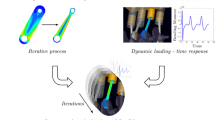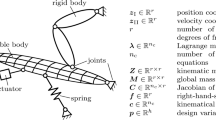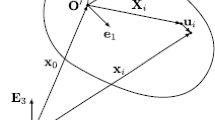Abstract
The paper presents a general optimization methodology for flexible multibody systems which is demonstrated to find optimal layouts of fiber composite structures components. The goal of the optimization process is to minimize the structural deformation and, simultaneously, to fulfill a set of multidisciplinary constraints, by finding the optimal values for the fiber orientation of composite structures. In this work, a general formulation for the computation of the first order analytical sensitivities based on the use of automatic differentiation tools is applied. A critical overview on the use of the sensitivities obtained by automatic differentiation against analytical sensitivities derived and implemented by hand is made with the purpose of identifying shortcomings and proposing solutions. The equations of motion and sensitivities of the flexible multibody system are solved simultaneously being the accelerations and velocities of the system and the sensitivities of the accelerations and of the velocities integrated in time using a multi-step multi-order integration algorithm. Then, the optimal design of the flexible multibody system is formulated to minimize the deformation energy of the system subjected to a set of technological and functional constraints. The methodologies proposed are first discussed for a simple demonstrative example and applied after to the optimization of a complex flexible multibody system, represented by a satellite antenna that is unfolded from its launching configuration to its functional state.
Similar content being viewed by others
References
Belytschko, T., Liu, W.K., Moran, B.: Nonlinear Finite Elements for Continua and Structures. Wiley, Chichester (2000)
Crisfield, M.A.: Nonlinear Finite Element Analysis of Solids and Structures, vol. 2: Advanced Topics. Wiley, Chichester (1997)
Géradin, M., Cardona, A.: Flexible Multibody Dynamics: A Finite Element Approach. Wiley, Chichester (2001)
Shabana, A.A.: Dynamics of Multibody Systems. Wiley, New York (1989)
Ambrósio, J.: Dynamics of structures undergoing gross motion and nonlinear deformations: a multibody approach. Comput. Struct. 59(6), 1001–1012 (1996)
Ambrósio, J., Kleiber, M. (eds.): Computational Aspects of Nonlinear Structural Systems With Large Rigid Body Motion. IOS, Amsterdam (2001)
Nikravesh, P.: Computer-Aided Analysis of Mechanical Systems. Prentice-Hall, Englewood Cliffs (1988)
Ambrósio, J., Gonçalves, J.: Complex flexible multibody systems with application to vehicle dynamics. Multibody Syst. Dyn. 6(2), 163–182 (2001)
Kane, T., Ryan, R., Banerjee, A.: Dynamics of a cantilever beam attached to a moving base. AIAA J. Guid. Control Dyn. 10, 139–151 (1987)
Garcia de Jalon, J., Bayo, E.: Kinematic and Dynamic Simulation of Mechanical Systems—The Real-Time Challenge. Springer, Berlin (1994)
Shabana, A.: Definition of the slopes and the finite element absolute nodal coordinate formulation. Multibody Syst. Dyn. 1, 339–348 (1997)
Dmitrochenko, O., Yoo, W.-S., Pogorelov, D.: Helicoseir as shape of a rotating string (I): 2D theory and simulation using ANCF. Multibody Syst. Dyn. 15(2), 135–158 (2006)
Gerstmayr, J., Schöberl, J.: A 3D finite element method for flexible multibody systems. Multibody Syst. Dyn. 15(4), 305–320 (2006)
Shabana, A.A., Wehage, R.A.: A coordinate reduction technique for transient analysis of spatial structures with large angular rotations. J. Struct. Mech. 11, 401–431 (1989)
Craig, R.R. Jr., Bampton, M.C.C.: Coupling of substructures for dynamic analyses. AIAA J. 6(7), 1313–1319 (1968)
Nikravesh, P., Lin, Y.-S.: Use of principal axes as the floating reference frame for a moving deformable body. Multibody Syst. Dyn. 13(2), 211–231 (2005)
Pereira, M., Proença, P.: Dynamic analysis of spatial flexible multibody systems using joint coordinates. Int. J. Numer. Methods Eng. 32, 1799–1812 (1991)
Yoo, W., Haug, E.: Dynamics of flexible mechanical systems using vibration and static correction modes. J. Mech. Transm. Autom. Des. 108, 315–322 (1986)
Liu, J.-F., Yang, J., Abdel-Malek, K.: Dynamics analysis of linear elastic planar mechanisms. Multibody Syst. Dyn. 17(1), 1–25 (2007)
Ambrósio, J., Ravn, P.: Elastodynamics of multibody systems using generalized inertial coordinates and structural damping. Mech. Struct. Mach. 25, 201–219 (1997)
Lehner, M., Eberhard, P.: On the use of moment-matching to build reduced order models in flexible multibody dynamics. Multibody Syst. Dyn. 16(2), 191–211 (2006)
Pombo, J., Ambrósio, J.: General spatial curve joint for rail guided vehicles kinematics and dynamics. Multibody Syst. Dyn. 9(3), 237–264 (2003)
Angeles, J., Lopez-Cajun, C.S.: Optimization of CAM Mechanisms. Springer, Dordrecht (1991)
Ambrósio, J.: Efficient kinematic joints descriptions for flexible multibody systems experiencing linear and non-linear deformations. Int. J. Numer. Methods Eng. 56, 1771–1793 (2003)
Gonçalves, J., Ambrósio, J.: Advanced modeling of flexible multibody dynamics using virtual bodies. Comput. Assist. Mech. Eng. Sci. 9(3), 373–390 (2002)
Muñoz, J., Jelenic, G.: Sliding joints in 3D beams: conserving algorithms using the master–slave approach. Multibody Syst. Dyn. 16(3), 237–261 (2006)
Cesnik, C., Hodges, D.: VABS: a new concept for composite rotor blade cross-sectional modeling. J. Am. Helicopter Soc. 42(1), 27–38 (1997)
Augusta Neto, M., Ambrósio, J., Leal, R.: Flexible multibody systems using composite materials components. Multibody Syst. Dyn. 12(4), 363–405 (2004)
Bauchau, O., Hodges, D.: Analysis of nonlinear multibody systems with elastic couplings. Multibody Syst. Dyn. 3, 163–188 (1999)
Augusta Neto, M., Ambrósio, J., Leal, R.: Composite materials in flexible computational multibody dynamics. Comput. Methods Appl. Mech. Eng. 195, 6860–6873 (2006)
Venkataraman, S., Haftka, R.: Optimization of composite panels—a review. In: Proc. of the 14th Annual Technical Conference of the American Society of Composites, Dayton, OH, 27–29 September 1999
Eberhard, P., Dignath, F., Kübler, L.: Parallel evolutionary optimization of multibody systems with application to railway dynamics. Multibody Syst. Dyn. 9, 143–164 (2003)
Eberhard, P., Schiehlen, W., Bestle, D.: Some advantages of Stochastic methods in multicriteria optimization of multibody systems. Arch. Appl. Mech. 69, 543–554 (1999)
Adelman, H.M., Haftka, R.T.: Sensitivity analysis of discrete structural systems. AIAA J. 24, 823–832 (1986)
Greene, W., Haftka, R.: Computational aspects of sensitivity calculations in transient structural analysis. Comput. Struct. 32(2), 433–443 (1989)
Haftka, R., Gürdal, Z.: Elements of Structural Optimization. Kluwer Academic, Dordrecht (1992)
Dias, J., Pereira, M.: Sensitivity analysis of rigid-flexible multibody systems. Multibody Syst. Dyn. 1, 303–322 (1997)
Dias, J.: Análise de sensibilidades e optimização de sistemas mecânicos rígido-flexíveis (Sensitivity analysis and optimization of rigid-flexible mechanical systems). PhD thesis, Instituto Superior Técnico de Lisboa, Technical University of Lisbon, Lisbon, Portugal (1999)
Bischof, C., Carle, A., Corliss, G., Griewank, A., Hovland, P.: ADIFOR: generating derivative codes from Fortran programs. Sci. Program. 1(1), 11–29 (1992)
Bischof, C., Carle, A., Khademi, P., Mauer, A.: ADIFOR 2.0: automatic differentiation of Fortran 77 programs. IEEE Comput. Sci. Eng. 3(3), 18–32 (1996)
Venkataraman, S., Haftka, R.: Structural optimization: what has Moore’s law done for us? In: 43rd AIAA/ASME/ASCE/AHS/ASC Structures, Structural Dynamics and Materials Conference, Denver, CO, USA, 22–25 April 2002
Vanderplaats, G.: DOT-Design Optimization Tools, Version 3.0. VMA Engineering, Colorado Springs (1992)
Cook, R.: Concepts and Applications of Finite Element Analysis. 2nd edn. Wileyand, New York (1987)
Duff, A., Erisman, Reid, J.: Direct Methods for Sparse Matrices. Clarendon, Oxford (1986)
Cavin, R., Dusto, A.: Hamilton’s principle: finite element method and flexible body dynamics. AIAA J. 15(12), 1684–1690 (1977)
Augusta Neto, M.: Optimization of flexible multibody systems with composite materials. PhD thesis, Mech. Engng Dept., Univ. of Coimbra, Coimbra, Portugal (2005)
Cesnik, C., Hodges, D.: VABS: a new concept for composite rotor blade cross-sectional modeling. J. Am. Helicopter Soc. 42(1), 27–38 (1997)
Popescu, B., Hodges, D.: On asymptotically correct Timoshenko-like anisotropic beam theory. Int. J. Solids Struct. 37, 535–558 (2000)
Bauchau, O., Hodges, D.: Analysis of nonlinear multibody systems with elastic couplings. Multibody Syst. Dyn. 3, 163–188 (1999)
Chang, C., Nikravesh, P.: Optimal design of mechanical systems with constraint violation stabilization method. J. Mech. Transm. Autom. Des. 107, 493–498 (1985)
Kim, M., Choi, D.: A new approach to the min-max dynamic response optimization. In: Bestle, D., Schiehlen, W. (eds.) IUTAM-Symposium on Optimization of Mechanical Systems, pp. 65–72. Kluwer Academic, Dordrecht (1996)
Gonçalves, J., Ambrósio, J.: Road vehicle modeling requirements for optimization of ride and handling. Multibody Syst. Dyn. 13(1), 3–23 (2005)
Haug, E., Arora, J.: Applied Optimal Design. Wiley, New York (1979)
Hsieh, C., Arora, J.: Design sensitivity analysis and optimization of dynamic response. Comput. Methods Appl. Mech. Eng. 43, 195–219 (1984)
Grandhi, R., Haftka, R., Watson, L.: Design-oriented identification of critical times in transient response. AIAA J. 24, 649–656 (1986)
He, Y., McPhee, J.: Multidisciplinary optimization of multibody systems with application to the design of rail vehicles. Multibody Syst. Dyn. 14(2), 111–135 (2005)
Eberhard, P., Bischof, C.: Automatic differentiation of numerical integration algorithms. Math. Comput. 68, 717–731 (1999)
Nelson, R.B.: Simplified calculation of eigenvector derivatives. AIAA J. 14(9), 1201–1205 (1976)
Dailey, L.: Eigenvector derivatives with repeated eigenvalues. AIAA J. 27(4), 486–491 (1989)
Duran, M.A., Grossmann, I.E.: An outer approximation algorithm for a class of mixed-integer nonlinear programs. Math. Program. 36, 307–339 (1986)
Geoffrion, A.M.: Generalized Benders decomposition. J. Optim. Theory Appl. 10(4), 237–260 (1972)
Gupta, O.K., Ravindran, A.: Branch and bound experiments in convex nonlinear integer programming. Manag. Sci. 31, 1533–1546 (1985)
Tawarmalani, M., Sahinidis, N.V.: Global optimization of mixed-integer nonlinear programs: a theoretical and computational study. Math. Program. 99(3), 563–591 (2004)
Ng, K.-M.: A continuation approach for solving nonlinear optimization problems with discrete variables. PhD dissertation, Stanford University, Stanford, CA (2002)
Anantharaman, M., Hiller, M.: Numerical simulation of mechanical systems using methods for differential-algebraic equations. Int. J. Numer. Methods Eng. 32, 1531–1542 (1991)
Author information
Authors and Affiliations
Corresponding author
Rights and permissions
About this article
Cite this article
Ambrósio, J.A.C., Neto, M.A. & Leal, R.P. Optimization of a complex flexible multibody systems with composite materials. Multibody Syst Dyn 18, 117–144 (2007). https://doi.org/10.1007/s11044-007-9086-y
Received:
Accepted:
Published:
Issue Date:
DOI: https://doi.org/10.1007/s11044-007-9086-y




